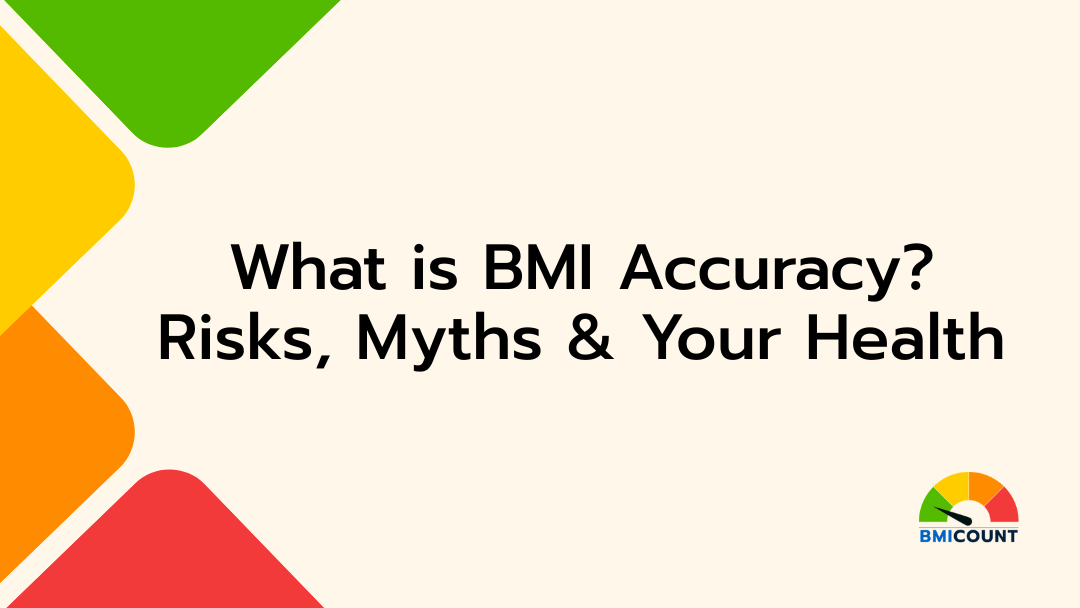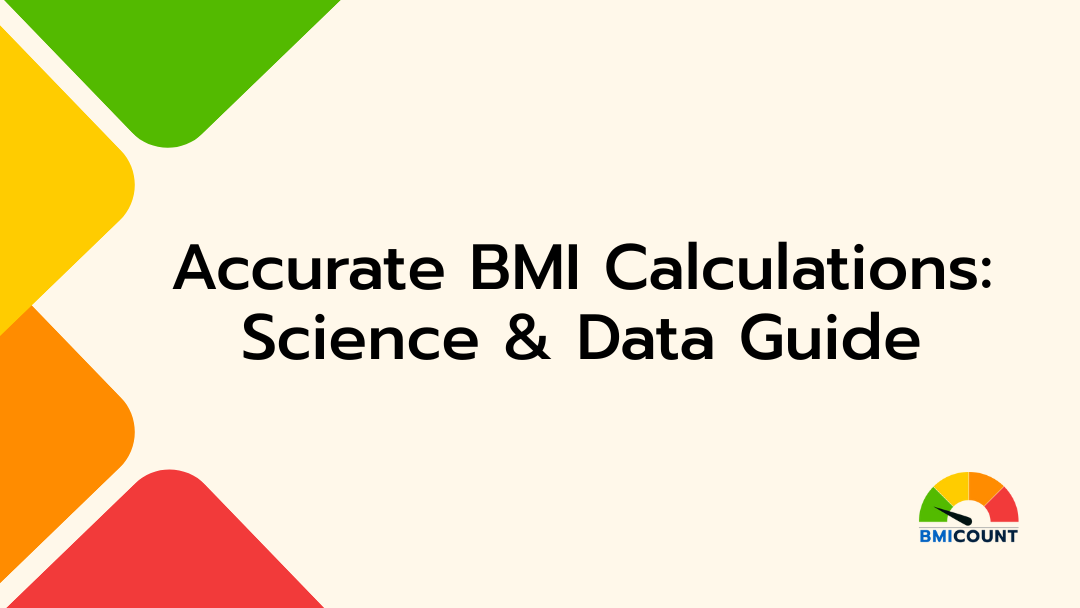Why Accuracy in BMI Calculation Matters
How to calculate BMI correctly is one of the most searched health questions and getting it right matters more than you might think.
Body Mass Index (BMI) is one of the most widely used tools in public health and personal wellness. It’s simple, fast, and accessible but it’s also surprisingly easy to miscalculate or misinterpret. While a BMI calculator can offer a quick snapshot of your health, its value depends entirely on how correctly you enter your data.
From entering centimeters instead of meters to rounding weight incorrectly, even small input mistakes can lead to misleading results. And because BMI is often used to guide important health decisions — like whether to seek nutritional advice or adjust exercise habits — it’s essential to get it right from the start.
This guide will walk you through exactly how to calculate your BMI accurately using both metric and imperial units, explain the formula behind it, and help you avoid common pitfalls. Whether you’re using BMI for general awareness or health planning, this step-by-step tutorial will give you the confidence to use the tool effectively and responsibly.
Related Reading: Want the complete picture of how BMI fits into your health journey? Start with our Complete Guide to the BMI Calculator.

“Your BMI result is only as accurate as the numbers you enter and most people get them wrong.”
Step 1: Choose Your Unit System — Metric vs. Imperial
Before you calculate your BMI, the first and most critical step is selecting the correct unit system. BMI can be calculated using either the metric system or the imperial system, but mixing units — even slightly — can lead to completely inaccurate results.
Metric System:
- Weight: kilograms (kg)
- Height: meters (m)
- Formula: BMI = weight (kg) ÷ [height (m)]²
- Example: 70 kg and 1.75 m → BMI = 70 ÷ (1.75 × 1.75) = 22.86
Imperial System:
- Weight: pounds (lbs)
- Height: inches (in)
- Formula: BMI = [weight (lbs) ÷ height (in)²] × 703
- Example: 150 lbs and 67 inches → BMI = (150 ÷ 4,489) × 703 = 23.49
Conversion Tips:
- 1 meter = 100 centimeters → Divide cm by 100 to convert (e.g., 175 cm = 1.75 m)
- 1 foot = 12 inches → Multiply feet by 12 and add remaining inches (e.g., 5 ft 7 in = 67 in)
Understanding which system you’re using — and how it affects the formula — is essential for getting an accurate result. If you live in the U.S., the imperial system is more common. In most other countries, the metric system is standard.
Quick Reference Table:
| System | Weight Unit | Height Unit | Formula |
|---|---|---|---|
| Metric | Kilograms | Meters | BMI = kg / (m × m) |
| Imperial | Pounds | Inches | BMI = (lbs / in²) × 703 |
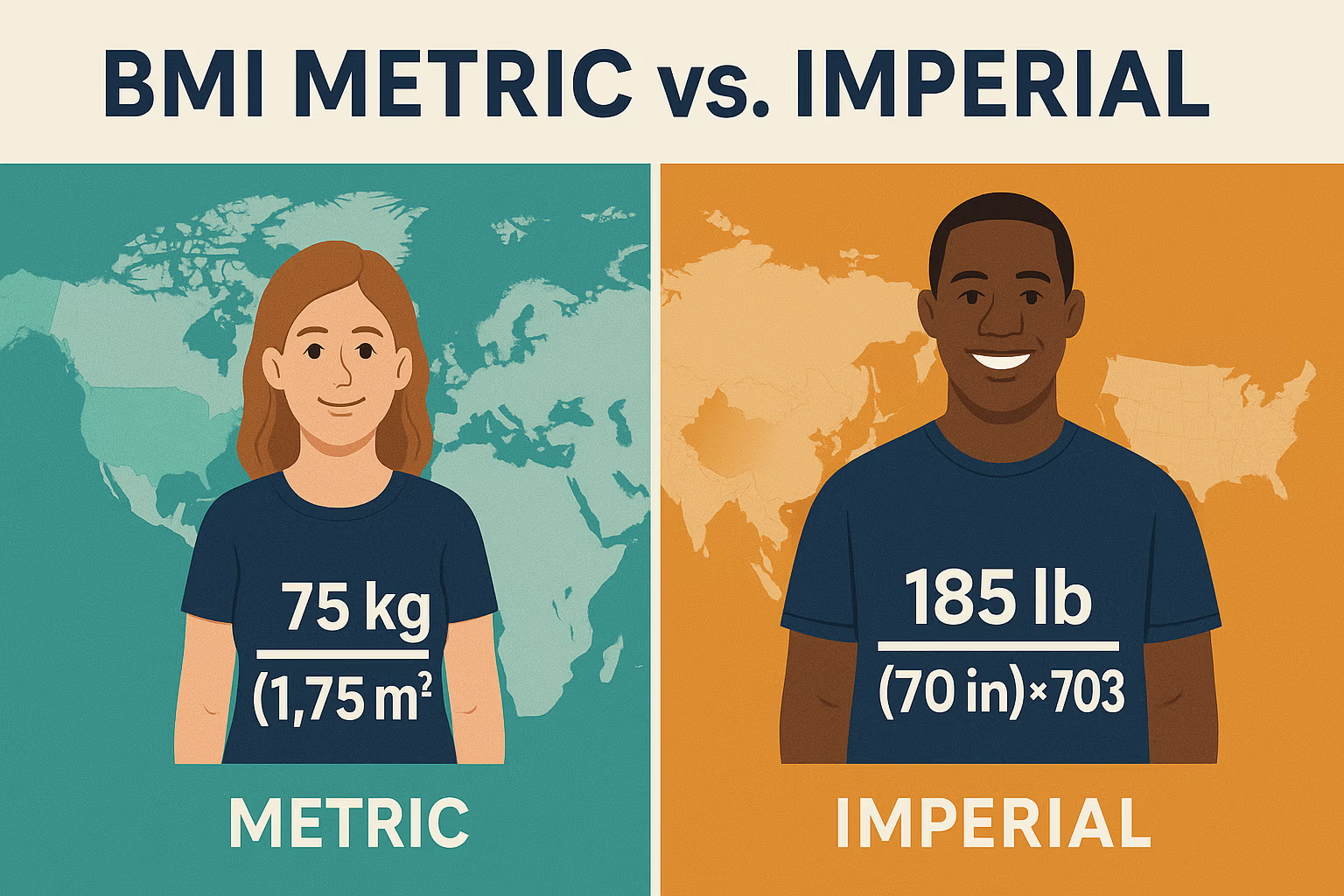
“The most common BMI mistake? Confusing centimeters with meters and it throws off everything.”
Step 2: Enter Your Details Accurately
Once you’ve selected the correct unit system, the next step is to input your personal information. This may seem simple, but small errors here are among the most common reasons people get misleading BMI results.
A quality BMI calculator—like the ones we offer at BMI Count asks for a bit more than just height and weight. Here’s a breakdown of each field and why it matters.
Required Inputs:
1. Weight
- Metric: in kilograms (kg)
- Imperial: in pounds (lbs)
- ➤ Tip: Use a digital scale first thing in the morning for best accuracy.
2. Height
- Metric: in meters (m) — convert cm by dividing by 100 (e.g., 172 cm = 1.72 m)
- Imperial: in inches (in) — multiply feet by 12 and add inches (e.g., 5 ft 8 in = 68 in)
3. Age
- Optional on many calculators, but highly recommended.
Age affects calorie needs, metabolism, and body composition.
4. Sex
- Male or female. Important for calculators that return caloric needs, ideal weight range, or body composition insights.
5. Ethnicity (Advanced tools only)
- Some calculators may factor in ethnic background for population-specific health risk assessments. This is based on studies showing BMI risk thresholds may vary across populations.
Use the Right Tool for Your Demographic:
| Demographic | Link |
|---|---|
| General | BMI Calculator |
| Men | BMI Calculator for Men |
| Women | BMI Calculator for Women |
| Kids | BMI Calculator for Kids |
| Teens | BMI Calculator for Teens |
| Seniors | BMI Calculator for Seniors |
“The more accurate your input, the more meaningful your BMI result even your age and sex can affect the interpretation.”
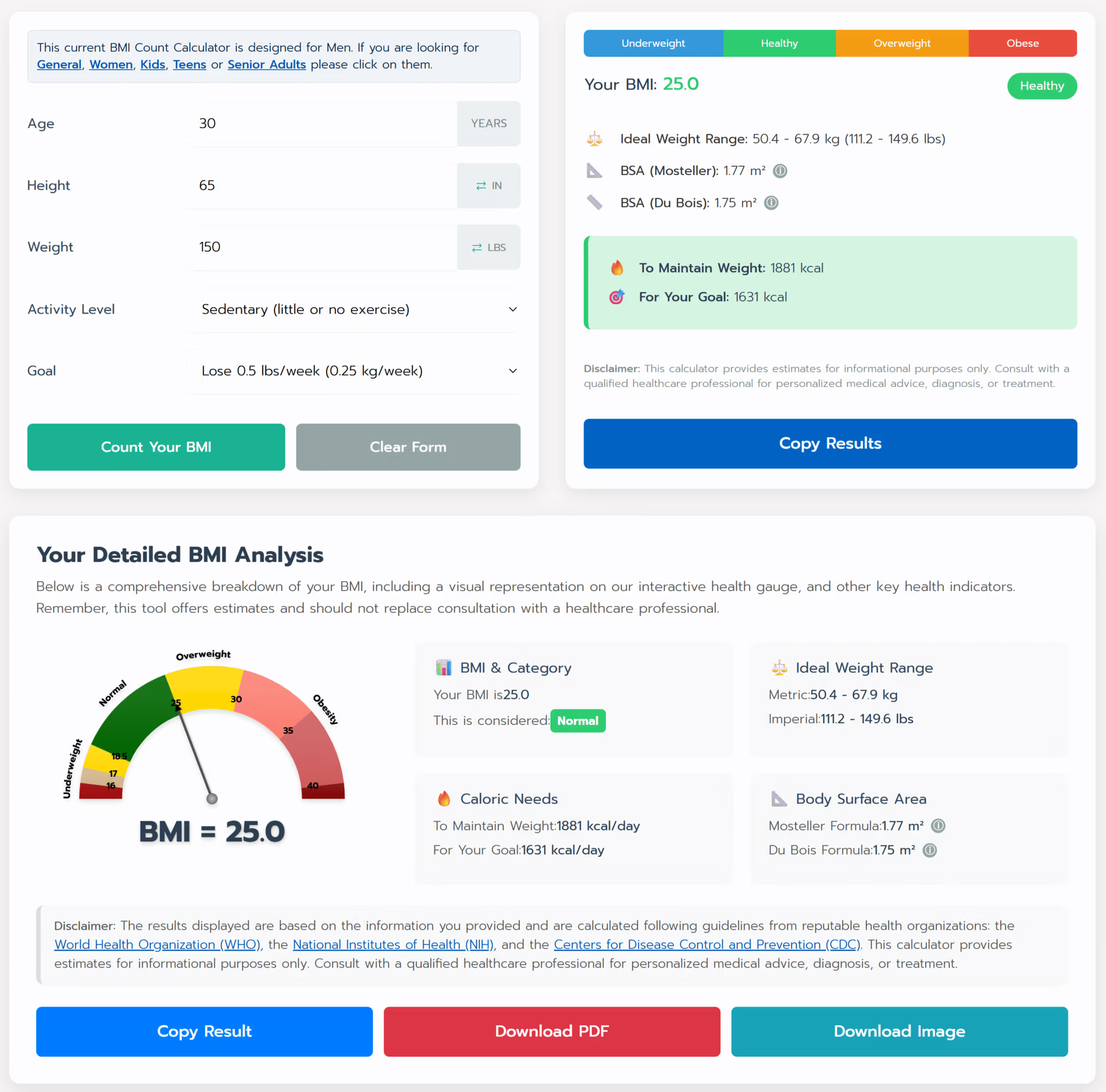
Step 3: Understand How to Calculate BMI and Formula
Knowing how to calculate BMI isn’t just about getting a number it’s about understanding what that number actually means. While most BMI calculators provide instant results, taking a moment to understand the formula helps you see how your inputs affect the outcome.
BMI, or Body Mass Index, is a mathematical equation that compares your weight to your height squared. It doesn’t directly measure body fat, but it serves as a widely accepted screening tool to estimate whether your weight falls within a healthy range for your height.
Because height is squared in the equation, even small errors like entering centimeters instead of meters can significantly skew your result. That’s why knowing how the formula works can help you avoid misclassification and get a more accurate picture of your weight status.
BMI Formula Explained
BMI Calculation Metric Formula
- BMI = weight (kg) ÷ height (m²)
- Example:
- Weight: 70 kg
- Height: 1.75 m
- BMI = 70 ÷ (1.75 × 1.75) = 70 ÷ 3.0625 = 22.86
BMI Calculation Imperial
- BMI = (weight (lbs) ÷ height (in)²) × 703
- Example:
- Weight: 150 lbs
- Height: 67 in
- BMI = (150 ÷ 4489) × 703 ≈ 0.0334 × 703 = 23.49
The two formulas produce the same BMI value when inputs are correctly converted and applied. The multiplier 703 in the BMI Calculation Imperial formula is used to scale the number appropriately to match the BMI Calculation Metric system.
Why Height Errors Matter So Much
Height is squared in both formulas. This means that even a small mistake in height (especially if entered in centimeters instead of meters) can greatly distort your BMI.
Because height is squared in the formula, even small entry mistakes can drastically change your BMI result. This is a key reason BMI is considered a useful but limited tool — it’s mathematically consistent, but not always medically complete.
Learn more in our Science & Data Behind BMI Calculations post.
Both formulas were developed from large-scale population studies, not individual diagnostics. If you’re curious about how BMI became a global standard — and where it falls short — check out our guide on BMI Accuracy, Risks & Misconceptions.
While BMI is easy to calculate, it doesn’t directly assess your body fat, muscle mass, or metabolic health. For more personalized strategies to improve what your BMI doesn’t show, explore our BMI & Lifestyle Management Guide.
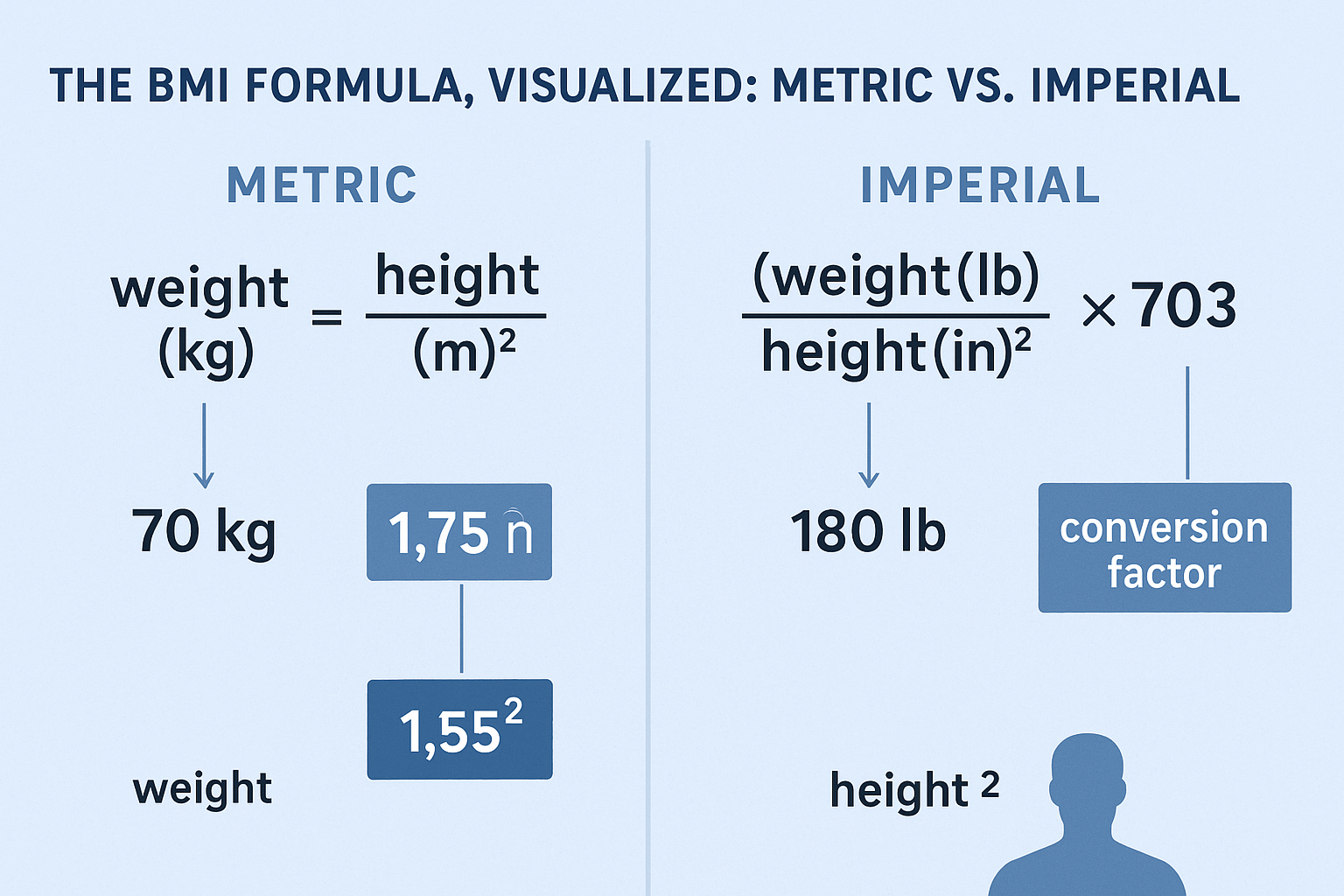
“Your height is squared in the BMI formula even a 5 cm error can send your BMI into the wrong category.”
Step 4: Interpret Your BMI Score Correctly
Once you’ve entered your information and received your BMI value, the next step is understanding what that number actually means for your health. BMI categories are defined by global health authorities like the World Health Organization (WHO) and the Centers for Disease Control and Prevention (CDC) and are used as a population-level screening tool.
It’s important to note: BMI is not a diagnostic tool. It does not measure body fat directly or account for other health indicators such as muscle mass, bone density, or fat distribution. Still, it offers a widely accepted starting point for assessing general weight status.
Standard BMI Categories (WHO Guidelines)
| BMI Range | Category |
|---|---|
| Below 18.5 | Underweight |
| 18.5 – 24.9 | Healthy Weight |
| 25.0 – 29.9 | Overweight |
| 30.0 and Above | Obese |
These categories are based on decades of research and serve as general guidelines. But depending on your age, sex, ethnicity, and fitness level, these thresholds may need to be interpreted with caution.
For example:
- A very muscular athlete may have a high BMI but low body fat
- An older adult may have a “normal” BMI but poor muscle tone and hidden health risks
- People of South Asian descent may face increased health risks at lower BMI thresholds than others
Related Reading: Want a deeper look at the limitations and risks of misinterpreting your BMI score? Explore our BMI Accuracy, Risks & Misconceptions Guide. Or, for a holistic view on what you can do after receiving your result, see our BMI & Lifestyle Management Guide.
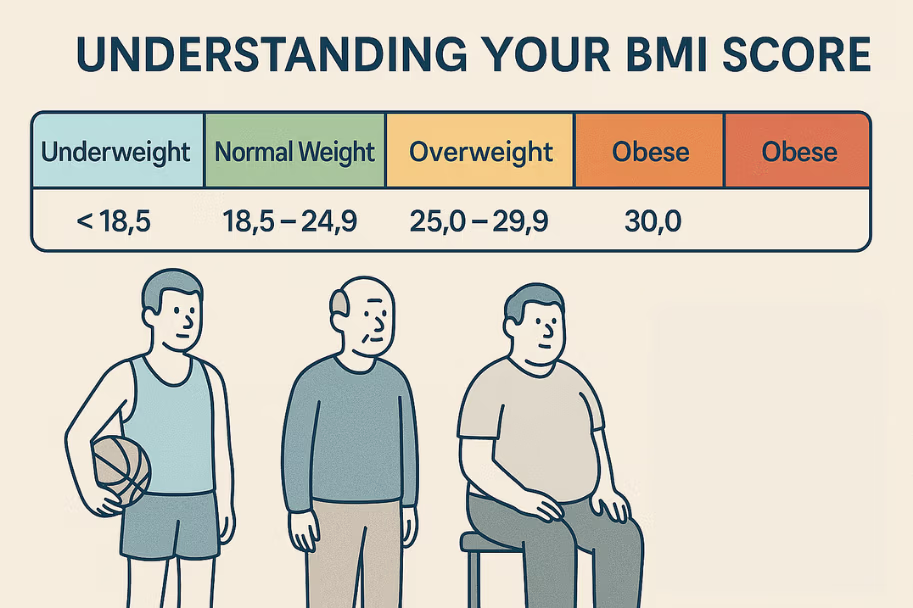
“Your BMI is a starting point, not a verdict it tells you where to look, not what to find.”
Step 5: Avoid Common Mistakes When Using a BMI Calculator
Knowing how to calculate BMI accurately isn’t just about plugging numbers into a tool it’s also about avoiding small, common mistakes that can significantly affect your results. While most calculators are designed to be easy to use, even minor input errors can lead to an incorrect BMI category.
Using a BMI calculator may seem straightforward, but even minor mistakes in how you enter your data can lead to inaccurate results or even put you in the wrong BMI category entirely. To ensure your results are meaningful and reliable, here are the most common user errors to avoid.
Common BMI Input Mistakes
- Confusing centimeters with meters (Metric only)
👉 Example: Entering 175 instead of 1.75 will drastically lower your BMI. - Mixing unit systems
👉 Example: Entering weight in pounds and height in meters produces an incorrect calculation. - Rounding height or weight too early
👉 Always input precise numbers, including decimals (e.g., 68.5 in, not 68). - Including shoes, jackets, or full pockets
👉 Weigh yourself without shoes or heavy clothing for accuracy. - Skipping age or sex (when available)
👉 These details refine your results, especially in tools that return calorie needs and ideal weight. - Using feet instead of inches (Imperial)
👉 BMI requires inches — multiply feet by 12 and add extra inches
(e.g., 5 ft 6 in = 66 in)
Tips for Accurate Input
- Weigh yourself in the morning before eating
- Stand tall without shoes for height measurement
- Double-check your unit selection before calculating
- Use a reliable digital scale and wall-mounted height chart
Helpful Tool: Not sure if you’re using the right calculator? Choose the one built for your needs:
If you’re learning how to calculate BMI correctly, the first step is understanding that the accuracy of your input is just as important as the formula itself. Double-check your numbers, use the right unit system, and take measurements consistently ideally in the morning, with minimal clothing, and on a flat surface.
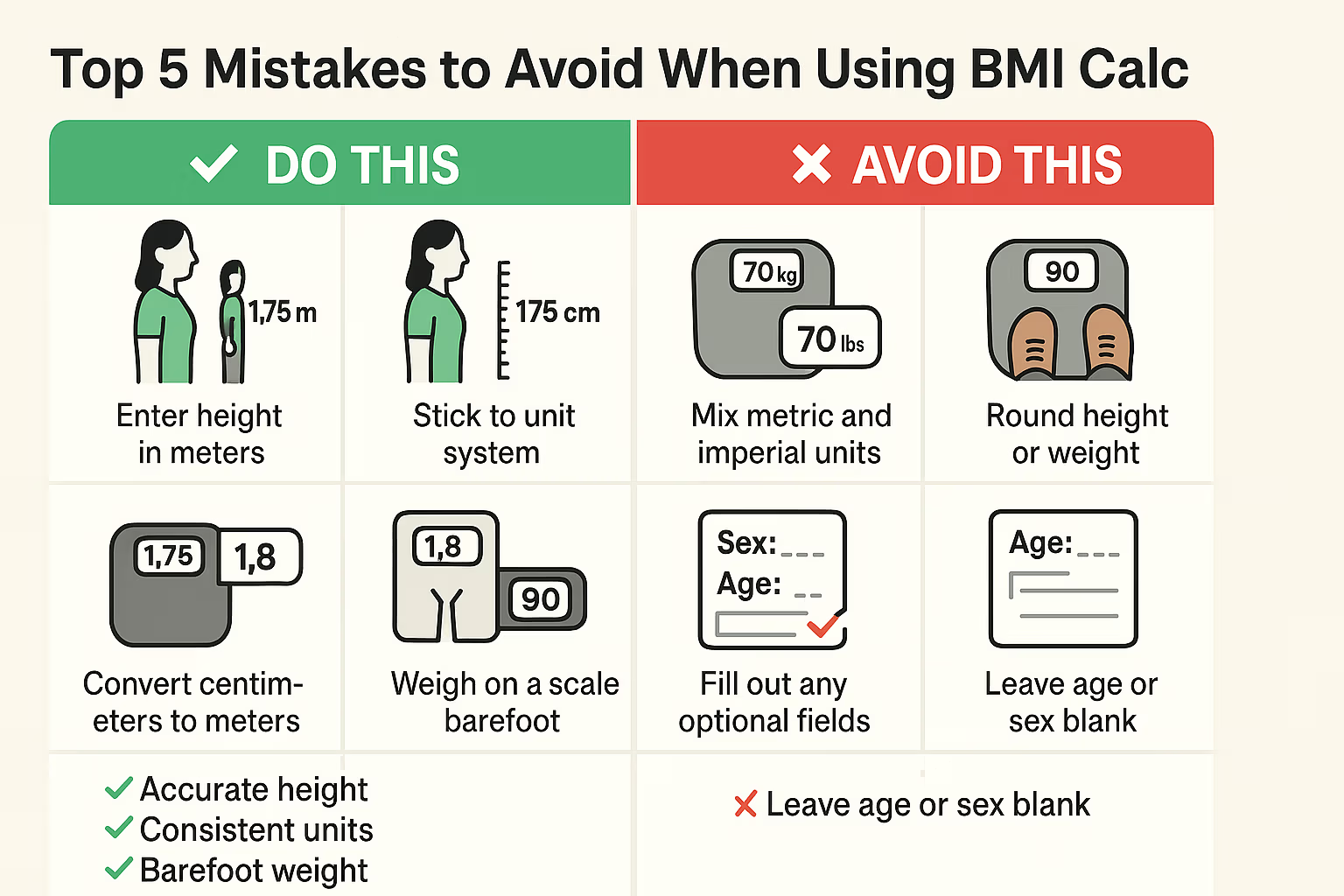
“Most BMI errors aren’t from the formula they’re from how you enter your height and weight.”
Bonus Insights When BMI Isn’t the Whole Picture
While BMI is a useful screening tool, it’s important to understand where its limitations begin. The number you get from a BMI calculator can tell you whether your weight is generally in a healthy range but it doesn’t reveal what that weight is made of, how it’s distributed, or how it affects your long-term health.
Here are some key contexts where BMI needs to be interpreted with care:
1. Athletes and Muscular Individuals
People with high muscle mass often receive BMI scores that classify them as overweight or even obese — despite having low body fat and excellent cardiovascular health.
Example: A professional rugby player might have a BMI of 28 (classified as overweight) but have under 10% body fat and a resting heart rate of 50 bpm.
2. Older Adults and Muscle Loss
As we age, we naturally lose muscle mass — a condition called sarcopenia. Older adults may have a BMI in the “healthy” range while still having low muscle tone and high visceral fat, which increases health risks.
Learn more in our BMI Calculator for Seniors, which focuses on muscle preservation and vitality over weight loss alone.
3. Ethnic Variations in Health Risk
Research shows that people from different ethnic backgrounds may face varying health risks at the same BMI. For example:
- South Asians may be at higher risk for diabetes and heart disease at lower BMIs
- Black populations may have higher bone density and muscle mass, affecting BMI interpretation
For more on how ethnicity plays a role, read our Science & Data Behind BMI Calculations
4. Fat Distribution: Waist Circumference Matters
BMI doesn’t tell you where your fat is located. Fat stored around the abdomen (visceral fat) is more dangerous than fat stored elsewhere.
➤ Quick Tip:
Measure your waist at the level of your belly button. For most adults:
- Women: under 35 inches
- Men: under 40 inches
According to the Mayo Clinic, waist circumference is one of the best complementary tools for assessing health risk alongside BMI.
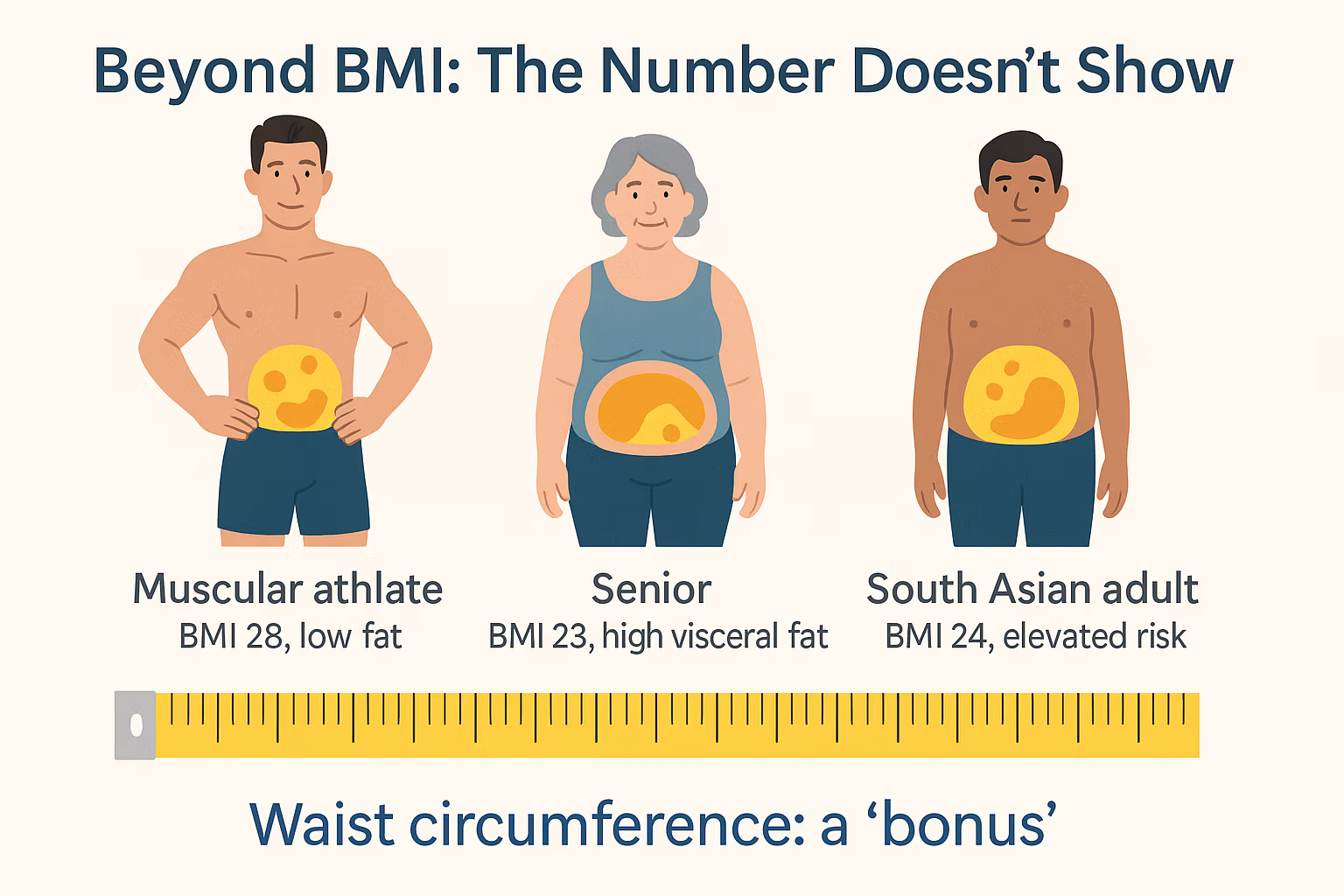
Final Thoughts
Once you’ve calculated your BMI correctly using the appropriate units and accurate inputs, the real value comes in knowing what to do with the result. BMI is not a judgment it’s a conversation starter about your health, and ideally, a strategy toward deeper insights and more personalized strategies.
Whether your BMI places you in the “healthy” range or flags potential risk, it should be viewed in context your age, activity level, body composition, and family history all matter. That’s why BMI Count offers a suite of specialized calculators designed for real people at every life stage.
Take the Next Step
Use the calculator that best matches your current needs:
Every tool provides:
- BMI value and category
- Ideal weight range
- Body surface area
- Daily caloric needs (TDEE)
Still unsure How to Calculate BMI and what your BMI means for your daily health habits? See our BMI and Lifestyle Guide to make informed, practical changes.
Frequently Asked Questions
How do I calculate BMI manually?
Use one of two formulas:
- Metric: weight (kg) ÷ height (m²)
- Imperial: (weight (lbs) ÷ height (in)²) × 703
Ensure you’re using the correct units throughout to avoid errors.
Should I use Metric or Imperial for BMI?
Either is acceptable, as long as you’re consistent. Metric is used in most countries outside the U.S., while Imperial is common within the U.S. Just be sure not to mix them during entry.
Why does my BMI seem high even though I’m fit?
BMI doesn’t account for muscle mass. Athletes and muscular individuals may have high BMIs despite low body fat and excellent health. In such cases, body composition testing provides better insight.
How often should I check my BMI?
For most adults, checking BMI every 3 to 6 months is sufficient. It’s more useful as a long-term trend indicator than a short-term tracker. Children’s BMI should be monitored by pediatricians during checkups.
Does age or gender affect BMI results?
The calculation remains the same, but interpretation differs. For example, BMI in children is based on percentiles, while older adults may have different health priorities such as muscle preservation.




